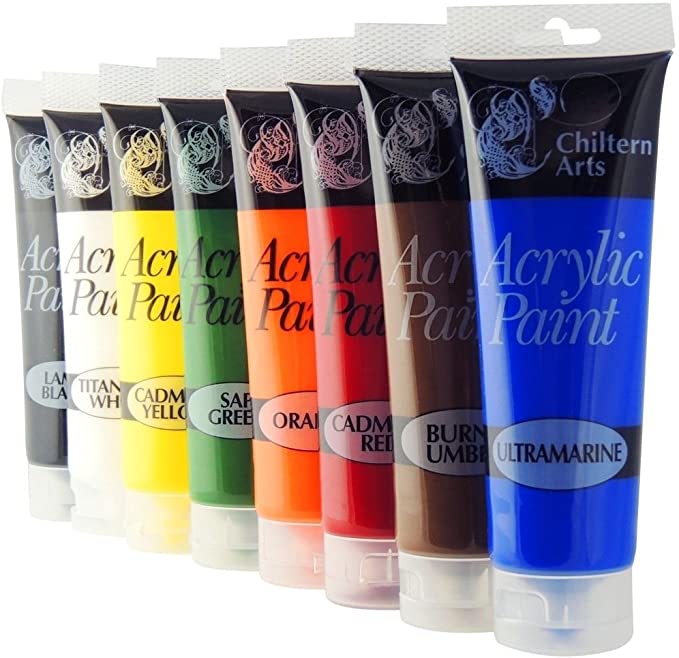
This article assumes you’ve done a few paintings in your spare time, maybe watched a PBS series on the activity, think you have some potential but can’t quite manage to make anything your friends would buy just yet. Here are some things to do to learn to paint some works you’re really proud of and improve your knowledge of a good painting composition.
I’ve been an acrylic painter for ten years. I’ve been taught by some of the best artists in my part of the world, and I have shown my work in galleries many times over the last decade. It sounds so obvious that it couldn’t be true, but I have to say, the best thing I ever did for my art was go to art school. I went through a very informal cirriculum with instructors who mainly gave advice here and there, observed and made suggestions when necessary, and subjected their students to rigorous peer review on a weekly basis. I didn’t sit through many lectures or follow many guidelines, but one thing I was encouraged to do was independent reading and research. Here I will try to provide the beginnings of what has led to my experience and try to throw out some knowledge I haven’t been able to find on the internet. Yes, believe it or not, there are books in libraries that can’t be replaced by a simple Google search. I won’t point to any specific resources right here, but I will make some suggestions later on as to where to find good reading material and how to judge a book by its cover, along with simple life experience that can only be passed on from one person to another.
I started painting in highschool the way many people these days begin. I learned from watching painting shows on educational television. This is free and actually very helpful for a beginner. You learn about tools, you learn the common colors used, and you learn a few simple shortcuts to work in detail. What they don’t teach on TV is much about content and composition, originality, or any of the in-depth, nitty-gritty details of the craft. Consider this to be a primer on these concepts of advanced painting.
Without further ado, here are some pointers to get you started.
Knowing how to make a good painting means knowing what a bad painting looks like. As many bad paintings don’t get reproduced or widely published, I would suggest going out to local galleries or paying a visit to an art school to view student work. Note your gut reaction to what you see. A big portion of quality in art is what you can’t really describe in words. Does the piece invoke an emotional response in you? Does the artist have any clear objectives to meet or a statement to make? Have these objectives been made, and is the statement made clearly and effectively? Most importantly, do you like the piece? If not, why not? These questions will make a viewer more aware of decisions he or she makes in his or her own work and help to build an individual style.
On to more concrete subjects, all beginning artists need a crash course in composition. Composition is the geometrical relationship between the forms depicted on the surface and the shape and edges of the surface itself. The tension between the subjects of the work and the edges of the support creates the most subtle, initial, and effective response in the viewer. For example, an object in the dead center of the canvas, or evenly dividing the canvas in half creates a feeling of static, unmoving space. The space around the object seems wasted and unnecessary. Centering the subject is one of the most common pitfalls of a beginning artist, and should be avoided unless done for a very specific reason. A prime example of the influence this positioning has on a painting composition is a work done by a non-objective artist in which a bold circle was placed slightly off center in one quadrant of an otherwise blank field. The piece could be rotated and displayed in four different ways, each giving a different feeling to the overall painting composition. This holds true for the entire spectrum, from abstract to representational, and even for paintings of several objects. Points of focus should be carefully arranged to guide the eye of the viewer in the desired manner. This is a form of passive manipulation of the viewer. For example, in a horror-genre painting, the eye could be guided away from the most sinister portion of the composition, tucked neatly away in a remote corner, only to be viewed as a surprise at the end of the viewer’s visual scan. One must always be aware that the eye really only takes in a limited amount of information over time, and thusly, a composition can have a temporal “plot”, much like a moving picture, such as a video or performance piece.
Color also plays an important part in composition. It should be an obvious conclusion to draw that positive and negative space should be in stark contrast to one another. But what if the values gradate in opposite directions? What if, for instance, your sky in the back ground begins a deep Prussian blue at the top of the composition, fading to a desaturated white at the bottom, and objects in the foreground begin at the bottom of the composition as dark shadows and gradually lighten to highlights at their tops? Somewhere in the middle, there may be points where the values of the foreground and background are nearly–or even completely–the same. These points are called passages, and actually play a very important part in making a composition dynamic. Passages can be deliberately placed around a composition in the same way as whole objects to guide the eye of the viewer. Passages can be merely singularities in value or can even be points where the foreground and background object are the exact same hue, tone, and value. When observing groups of objects in real life, try to become aware of the passages between them, and how they influence your visual scan. Good places to look are crossing branches of a tree, a display at a grocery store, or a group of people walking in the street.
These are a few of the visual elements of a painting composition, but how should they be arranged? This all depends on the intended effect on the viewer. Classical forms of painting composition include circular, linear, and triangular. How these look when laid out on a surface should be obvious. A circular composition gives the viewer a feeling of dynamicism in a composition, but also of stability, as the eye is never led off the edge of the piece. A triangular composition is itself composed of diagonals. Diagonal lines are a very powerful gesture in a composition, giving the feeling of unstable movement. The whole triangular aspect of the composition gives it a grounded feeling, however, as opposing diagonals are balanced on a fixed point. Linear composition could mean objects are arranged in a straight line, be it horizontal, vertical, or diagonal, or objects could be placed in a winding or curved fashion along the composition. A horizontal line generally gives the piece a relaxed feel, like a person reclining in a hammock or a pastoral scene with a straight and level horizon. A vertical line gives the feeling of strength and rigidity, like a standing statue or a soldier at attention. A winding painting composition conveys a feeling of crowdedness, clutter, or chaos, such as in a large group of people standing in disarray, or a spiraling mountain road. These are just a few of the possibilities, granted the most commonly used. Hopefully they will provide enough options to avoid the pitfall of a centered object in dead space.
One more important note on painting composition: the proximity of an object to an edge of the piece is also very important. An object can be so far away from an edge as to be seemingly unrelated, could actually go off the edge, or could come very close to an edge without running off. This latter case is very special and much like perfectly centering an object, should be avoided until one understands the implications and particular tensions this placement brings with it, but can eventually be an important tool to the artist. Running an object off the edge of a piece tends to expand the understood space of the surface beyond its physical boundries, giving the piece more of a feeling of one being able to walk into it. This is especially true of a lifesized or larger composition. A prime example of this would be a woodland scene in the order of seven or eight feet tall, with a human figure walking onto one edge and trees extending off the top and bottom edges.
And finally, where to find more information. Of course, the most valuable sources are images themselves. Visiting exhibitions and museums is definitely very helpful. Another good source is a local university art library. There you will be able to find thousands of books full of images. Find a few artists or a movement you like and study as many of their works as possible. There are also plenty of texts on theory and practice. If a book such as this feels heavy in your hands, it probably has some information you never would have thought of by yourself. I would suggest books such as this on any particular subject should at least deserve a scan through their tables of contents, and maybe even a deep reading of a chapter or two. All this book work can seem dense and boring, but think of it as a quest for information no one else could find, and you’ll quickly become the teacher.
Thank you for reading this article! If you have any further questions about this topic please contact us.

